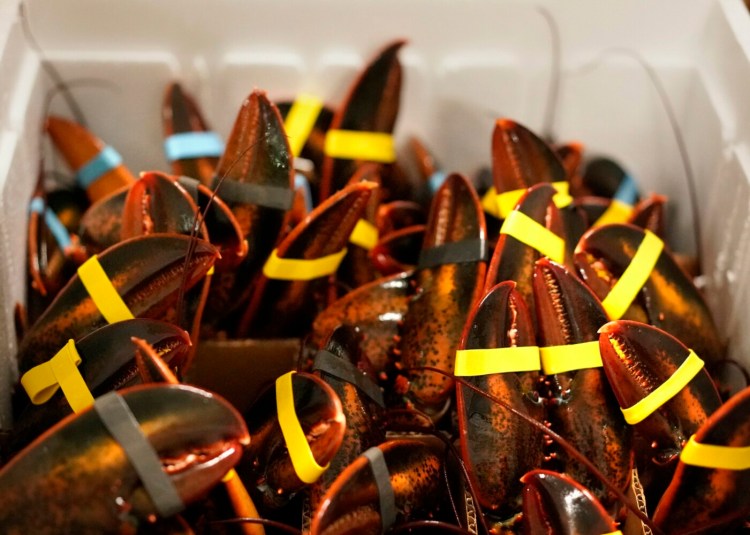The limited trade deal signed by the U.S. and China on Wednesday is probably good news for Maine’s lobster industry, which saw its Chinese exports fall 47 percent in the year after the trade war broke out, but insiders cautioned it’s too early to say just how good.
The deal doesn’t reduce tariffs on Maine lobster but it includes a provision requiring China to buy $32 billion worth of U.S. agricultural goods over the next two years, including seafood. Still, it will be up to China to decide what it will buy to fulfill that commitment. Industry officials hope at least some of it will be spent on Maine lobster.
Sen. Susan Collins of Maine said she was pleased to see lobster highlighted in notes included in the part of the agreement that described China’s agricultural buying mandate. The Republican said she lobbied U.S. Trade Representative Robert Lighthizer to get that provision included.
“The inclusion of this provision … is a significant victory for Maine’s lobster industry, which has been unfairly harmed by retaliatory tariffs,” Collins said in a statement. “I appreciate (Lighthizer’s) responsiveness to the concerns industry members and I raised, and for his efforts to secure the provision in the agreement.”
Sen. Angus King and Rep. Jared Golden of Maine also praised the agreement and the possible relief it could provide for the state’s $485 million lobster industry.
“Today appears to provide some long-awaited good news for our hard-working lobstermen and lobster dealers in the face of a difficult time,” said King, an independent. “The deal includes a commitment that China will purchase lobster in the coming years – but I am concerned the language does not appear to specify a minimum purchase amount, nor does it remove the existing tariffs so our lobster can be competitively priced with Canadian lobster.”
Golden also welcomed the agreement, but said that regulations also pose a threat to the lobster fishery, an apparent reference to a state proposal to protect endangered right whales.
“I’m hopeful that the changes in the Phase One Trade Agreement announced today will indeed have a positive impact on the industry,” said Golden, a Democrat who represents Maine’s 2nd Congressional District. “In the meantime, I’ll continue to focus on what lobstermen are telling me they’re most concerned about: unfair, misguided regulations on our lobster fishery.”
In the agreement, China agrees to buy an additional $12.5 billion worth of U.S. agricultural goods in the next year, and another $19.5 billion in the second year of the two-year deal, according to text of the agreement released by the U.S. Trade Representative’s Office Wednesday.
It wasn’t clear Wednesday night whether the trade deal would help growers of Maine wild blueberries, a crop that also has been affected by the tariffs.
When it comes to trade talks, lobster is usually categorized as an industrial good, and not an agricultural one. The reclassification landed it on China’s mandatory shopping list, and represents a “big opportunity for the industry,” said Annie Tselikis, executive director of the Maine Lobster Dealers Association.
“The fact that lobster is the only seafood item named in the trade deal is incredible,” Tselikis said. “While we don’t know how much lobster that will turn out to be, it’s the only seafood mentioned, so I think it represents a big step in the right direction for an industry that could really use a boost.”
Maine’s live lobster sales to China fell by 46.7 percent, or $82.1 million, in the 12 months after the tariff was imposed in July 2018, according to federal trade data. Sales revenue fell from $175.9 million the prior year to $93.8 million in the 12 months after the tariff.
As a result, China turned to Canada to satisfy its craving for lobster without a tariff-inflated price tag.
The agreement comes just 10 days before the Lunar New Year, a time of the Chinese calendar when demand for lobster is at its highest and U.S. exports in past years have surged. Maine dealers are anxious to see if their phones will start ringing as they head into what would have been one of their busiest weeks.
Dealers seek a return to the heady days before the trade war, when China dominated overseas sales.
In the summer of 2017, The Lobster Co. was selling $100,000 of lobsters a day to Beijing, Guangzhou, and Shanghai, owner Stephanie Nadeau said. After seven years of building the China market, it had come to account for a third of the Arundel company’s annual sales.
The trade war cost Nadeau $10 million in 2018 sales. Eighteen months later, her sales are 40 percent of what they were before the tariff, and her workforce is half what it was. Nadeau said she has no idea what the limited trade deal will mean for her or her industry.
“My customers aren’t going to come running right back after 18 months,” she said.
Send questions/comments to the editors.




Comments are no longer available on this story